Here’s a clue: It’s all in Balenciaga and their use of norm-core trash bags, the duct tape dresses and dirty shoes.
It sounds like the start of a bad joke; three people walk into a room, Balenciaga, The Simpsons and Andy Warhol… but I’ve never been any good with punchlines, so that’s the end of that. What I have been doing, however, is observing the obvious; Balenciaga loves a shock factor. First came the duct-tape dress. Then the trash bags, dirty shoes, Ikea mimetic and stuffed teddy bears. What started off as a boutique Spanish brand of the 1980s, became the playing grounds for Nicholas Ghesquière in the early 2000s and has culminated in Demna Gvasalia‘s glorification of Balenciaga norm-core; now becoming a brand that plays with culture and consumerism with an Andy Warholesque resemblance.

Balenciaga and Celebrities
I’m convinced there’s a graph out there that correlates Balenciaga sales with Cardi B, J Balvin and Bad Bunny‘s release of “I Like it Like That”… and if there isn’t somebody should create it. “I like those Balenciagas (Those), the ones that look like socks” was perhaps many people’s first contact with the Spanish brand, a catapult of sorts into the pop-culture sphere that brought the sock-like garments into the mainstream. Marketing-wise, it was a brilliant move. There it was, a single lyric acting as the bridge between two realms; that of fashion and music, exclusivity and the mainstream.
Nowadays the bridge looks slightly different. Although we may not be hearing Balenciaga in our songs, we’re seeing it pop in our feeds. Kim Kardashian has namely become the brand’s most prominent voice, serving as the brand’s test of ideas and a clever influencer campaign to bring Balenciaga’s designs into the mainstream. She was the one that wore the duct tape dress. She tested the all-black matrix sunglasses. The curvaceous body dresses. In turn, the public responded.
Of course recent events have left Balenciaga friend-less in the playground. Their latest campaign, which featured children sexualised alongside BDSM plush-toys, empty drink glasses and court documents, has launched an avalanche of cancel culture through which Balenciaga is struggling to stay afloat. Celebrities previously affiliated with the brand have been quick to cut ties, and those that haven’t have faced a demanding public knocking on their doors. The band and pop culture are so intrinsic to each other that not denouncing them could turn into career suicide at its finest.
Balenciaga and Pop Culture

In my personal understanding of fashion history, Moschino’s fresh fragrance was the first time I saw a high-end brand play with the idea of the conventional. It didn’t get more coded luxury than a cleaning product shaped perfume bottle being sold at 37GBP. Ever since, we’ve seen it pop around everywhere, in Balenciaga’s case namely on the creation of trash bag purses, or Ikea bags. And these things make headlines. People are fascinated with the overlap, the idea that their laundry bags could be glorified into the luxury fashion realm provides a degree of accessibility which luxury has always notoriously lacked, but always revelled on.
This is food for thought.
On the one hand it serves as an open door. I wouldn’t be surprised if there was an intrinsic link between these Balenciaga norm-core products and fashion’s acceptance of DYI and rejection of fast fashion. Whilst high street labels have always been championed by industrial-made garments, consumerist trends are shying away from factory-made defaults and instead embracing craft, handmade and all its quirks – and Balenciaga’s accessibility helps demystify the luxury in its favour.
On the other hand, it’s the ultimate form of satire. For their controversial Gift Shop campaign, Balenciaga is charging 650EUR for a lunch box. 250EUR for a Starbucks sip-cup mimic. At one point they even sold candles on beer bottles (which are no longer on the website) for yet another ridiculous price point. There’s simply no way this isn’t Demna laughing at consumerism, cult-following and the rich. I refuse to believe these products are actually worth the price, or that by simply pasting the Balenciaga name onto norm-core products they are suddenly worth as much as somebody’s rent.
The Satire Factor


Google defines satire as “the use of humour, irony, exaggeration, or ridicule to expose and criticise people’s stupidity or vices, particularly in the context of contemporary politics and other topical issues.” I first learnt what satire meant in my English class back in school, and my pop-culture obsessed teacher used The Simpsons, no less, as a reference. The analogy stuck and years later is still the first thing I think of when I come across the term – good on you Ms. Smith.
Although I am sure if I held a microphone up to Demna he would never admit it, I’m convince Balenciaga is carrying out a satirical sociological experiment of sorts. It’s almost as if they were on the hunt for some answers. How much can we push our customers? What is our fanbase willing to stand behind? How strong is the Balenciaga brand? The answers: quite far, not behind child sexualisation and very strong (albeit not post-controversy, we’ll see how it develops).


The Idea of a Cult
The interesting point to explore here is that of the Balenciaga fanbase. Note how, perhaps a few years back, this would’ve been the wrong terminology. A fanbase for a music group, film star or celebrity? Sure. Fan-base for a brand? More like customer, right?
DDW has spoken about it before; Luxury has always been envious of the cult-like following of streetwear brands. Through collaborations between the two realms, luxury is slowly gaining back confidence, and in turn is gathering loyal clientele. For brands like Balenciaga, which have also made an effort in seeping into influencer celebrity culture, it works particularly well – ask the 14,3M followers the brand has on Instagram, when they have nothing but one or three posts ever visible. For the most part, this is such a safety cushion. Balenciaga could practically release anything within reason and have people support it, much like Elon Musk when he released his very own fragrance with terribly outdated product design, satire marketing and excessive pricing.
On High and Low Art
Everyone knows about Andy Warhol’s Heinz soup artwork. A commentary on mass production, demystification of art through household items, playing with high and low culture and commenting on consumerism; that’s what Warhol was all about. Demna is doing the exact same thing with fashion. The Balenciaga Gift shop sells mugs and cutlery with branding that resembles that of the Hilton hotels. Stella Artois-like logos adorn some of the wine glasses on sale. Monster-like logo mugs. It’s giving Balenciaga norm-core galore.
The Ultimate Test
So back to the non-funny joke from the beginning. What do Balenciaga, The Simpsons and Andy Warhol have in common? Perhaps a play consumerism, or it’s the raw satire. Either way, the strategy is marketing gold, and up until recently Balenciaga had been doing surprisingly well. Now, with its current controversy their loyalties have been put to the ultimate test. Whilst the brand is taking to court those responsible for the Gift Shop campaign shoot, fans are viciously attacking any public demonstration of support for the brand.
For the time being, Demna remains under the microscope.


